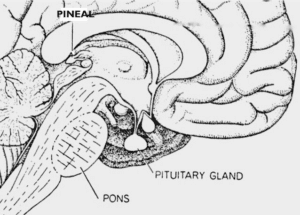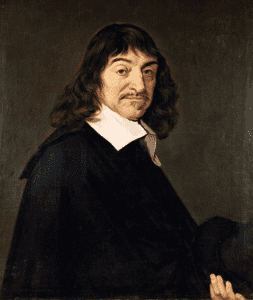JMS Pearce
Hull, England, United Kingdom
 |
| Fig 1. Pineal gland |
The pineal for millennia had been a structure of mystery. In Ancient Egyptian culture, The Eye of Horus was a sign of prosperity and protection, often referred to as the third eye. In Ayurvedic physiology it corresponds to the sixth chakra—Ajna, located in the middle of the forehead, representing intelligence, insight, and a cosmic window into spiritual life.
Erasistratus (c. 260 BC) from the Alexandrian school described the flow of spirits: air was carried through heart and lungs to the brain1 where it was transformed into pneuma psychikon in Greek, or spiritus animalis in Latin, and was the basis of the psyche, motion, sensation, and thought. Herophilus (c. 330–c. 260 BC) and Galen considered the ventricles to be the seat of both soul and mental functions. Herophilus thought that the pineal acted as a valve or sphincter controlling the flow of pneuma psychikon from the middle to the posterior ventricle.2 Pneuma was distributed widely from the brain through the nerves. Both Erasistratus and Herophilus realized the brain was the site of the soul and intelligence (encephalocentric), contradicting Aristotelian (cardiocentric) opinions of their origins in the heart.
Galen of Pergamum (129–199 AD) in his De anatomicis administrationibus recognized the pineal body as a small mid-line structure lying behind and above the third ventricle in humans (Fig 1) and on the dorsal surface of the brain in lower vertebrates. He invented the term konareion — “pineapple” in Greek. In his book De usu partium he said its function was unrelated to the soul (psychic pneuma), which was located in the ventricles: the pineal was merely a glandular support for the mass of cerebral veins of the midbrain.3 At this time, the anterior ventricle (the two lateral ventricles regarded as one) was believed to be the organ of imagination, the middle ventricle the organ of reason, and the posterior ventricle the organ of memory. These concepts persisted until Descartes in the seventeenth century.
The great philosopher and mathematician René Descartes (1596–1650) of Touraine (Fig 2) is best known for his proposition: cogito ergo sum (I think therefore I am). His account of pineal function is found in The Passions of the Soul (1649) and elaborated in L’Homme (published posthumously in 1664). He recognized two independent substances: Res cogitans, a substance of mind and thought, and Res extensa, an extended substance, his physical universe. This is an aspect of the famous Cartesian dualism of mind and matter. The pineal was the seat of the soul: “the small gland which is the principal seat of the soul is suspended within the cavities containing these spirits, so that it can be moved by them…”
 |
| Fig 2. René Descartes. Portrait possibly by van Hals. Louvre Museum via Wikimedia. Public domain. |
Descartes believed that animal spirits flowed from the pineal gland through hollow tubes. Pores between the tiny fibers of the substance of the brain connected the sense organs with small valves in the walls of the ventricles. When stimulated, they pulled on the small fibers in the nerves, opened the valves connected to these fibers, and released animal spirits from the ventricles to produce sensory perceptions.
Thus, Descartes believed sensation, imagination, memory, and bodily movements were derived from the pineal.4 The eyes perceived the outside world and transmitted what they saw to the pineal via fibers in the brain.
This was the first advance in the emergence of the mind-body dilemma, which is still unresolved: How does mind act causally on the brain or vice versa?5 In 1687, after Descartes, Newton’s three laws of motion founded deterministic classical physics, the Res extensa. But how the dualism of mind and spirit related to physiological function was unresolved.
Thomas Willis described in 1681 the glandula pinealis, a “kernel” in the form of a pineapple, or conarium, a cone. He noted: “we can scarce believe this to be the seat of the Soul, or its chief Faculties to arise from it; because Animals, which seem to be almost quite destitute of Imagination, Memory, and other superior Powers of the Soul, have this Glandula or Kernel large and fair enough” (in Cerebri anatome cui accessit nervorum descriptio et usus 1664). Fifty years later, many philosophers still regarded the pineal as the seat of the soul, but how it worked remained unknown for centuries, during which wild speculations abounded. The anatomist Nils Holmgren in 1918 showed that in the frog the pineal contained distinct sensory cells resembling the cone cells of the retina. It was considered a vestige of a primitive light-sensing organ or photoreceptor, the “third eye,” a view later confirmed.6
One clue was that precocious sexual development occurred in boys with pineal tumors.7 This resulted in the idea of the pineal as an endocrine gland secreting sex hormones, though it was later discovered that the pineal modulates such activity via pituitary gonadotrophic hormone secretion. Previously, glands were thought to secrete hormones into the blood and were themselves regulated by other hormones in circulating blood to achieve homeostasis.8 Only when it was appreciated that neural information was transduced into endocrine information—neurosecretion—was this fundamental mechanism clarified. We now know that the pineal derives from the neuroectoderm. It acts as a biological clock, activated by environmental light and converting cyclical (circadian) neural activity into hormonal endocrine function.
In humans the pineal measures only 7–8 mm long and weighs approximately 0.15 g. It often calcifies (“brain sand”), providing a midline point of reference on X-ray images. Pinealocytes contain photoreceptors, have a sympathetic innervation, and neurosecretory function. Lizards and frogs sense light via a third parietal eye containing photoreceptor cells resembling the cones of the lateral eye, which act as a sun-calibrated compass. (Fig 3)
 |
| Fig 3. Lizard third eye. Wired, August 31, 2009. |
The pineal was to plays a vital role in human physiology. Neurosecretory systems include the hypothalamic posterior-pituitary system; pituitary polypeptide releasing factors in the hypothalamus; and the adrenal medulla, which responds to the autonomic nervous system. A central pacemaker or biological clock in the suprachiasmatic nucleus of the hypothalamus coordinates circadian rhythms. This adapts slowly to changes in time zones; peripheral clocks or oscillators adapt at different rates. These complex functions are mediated by the pineal, which secretes melatonin (N-acetyl-5-methoxytryptamine)9 synthesized from a precursor, 5-hydroxytryptophan. They are involved in regulating sexual development, metabolism, and circadian rhythms in many vertebrates.
The synthesis and release of melatonin are stimulated by darkness. Melatonin has been called the chemical expression of darkness—inhibited by light. Melatonin secretion peaks between 2 and 4 a.m. and mediates a phase shift of the circadian clock, increasing alertness, heart rate, and pupil constriction.
These “chronobiotic” effects of light and melatonin have been used to alleviate disorders of circadian rhythm such as jet lag10 and sleep patterns of night-shift workers. Short courses of oral melatonin are often used at bedtime.
Descartes’ speculations were impressively prescient. The discovery of melatonin has advanced us a little from his Treatise of Man, which stated: “My view is that this gland is the principal seat of the soul, and the place in which all our thoughts are formed.”
References
- Pearce, JMS. The Neurology of Erasistratus. J. Neurol Disord 2013, 1:1.
- Pearce JMS. The Neuroanatomy of Herophilus. Eur Neurol 2013;69:292-295.
- López-Munoz F, et al. La glándula pineal como instrumento físico de las facultades del alma: una connexion histórica persistente. Neurología. 2012;27:161–8.
- Lokhorst, Gert-Jan. Descartes and the Pineal Gland. The Stanford Encyclopedia of Philosophy Winter 2021; (Metaphysics Research Lab, Stanford University).
- Kauffman, S, & Radin D. (2021, January 2). Is Mind Quantum? https://doi.org/10.31234/osf.io/qejzr
- Holmgren, N. Zur Frage der Epiphysen-Innervation bei Teleostiern. Folia neurobiol. (Lpz.) 1917;10, 1–15.
- Axelrod J, Fraschini F, Velo GP. (eds.) The Pineal Gland and its Endocrine Role. Springer, 1983.
- Wurtman RJ, Axelrod J. The Pineal Gland. Scientific American, 1965;213:50-63.
- Lerner AB, Case JD, Takahashi Y, Lee TH, Mori W. Isolation of melatonin, the pineal gland factor that lightens melanocytes. J. Am. Chem. Soc 1958; 80, 10: 2587.
- Arendt J. Approaches to the Pharmacological Management of Jet Lag. Drugs. 2018;78(14):1419-1431.
JMS PEARCE is a retired neurologist and author with a particular interest in the history of science and medicine.

Leave a Reply